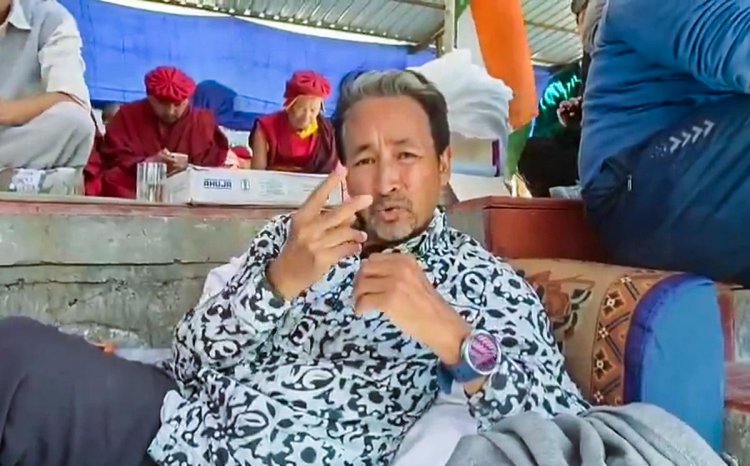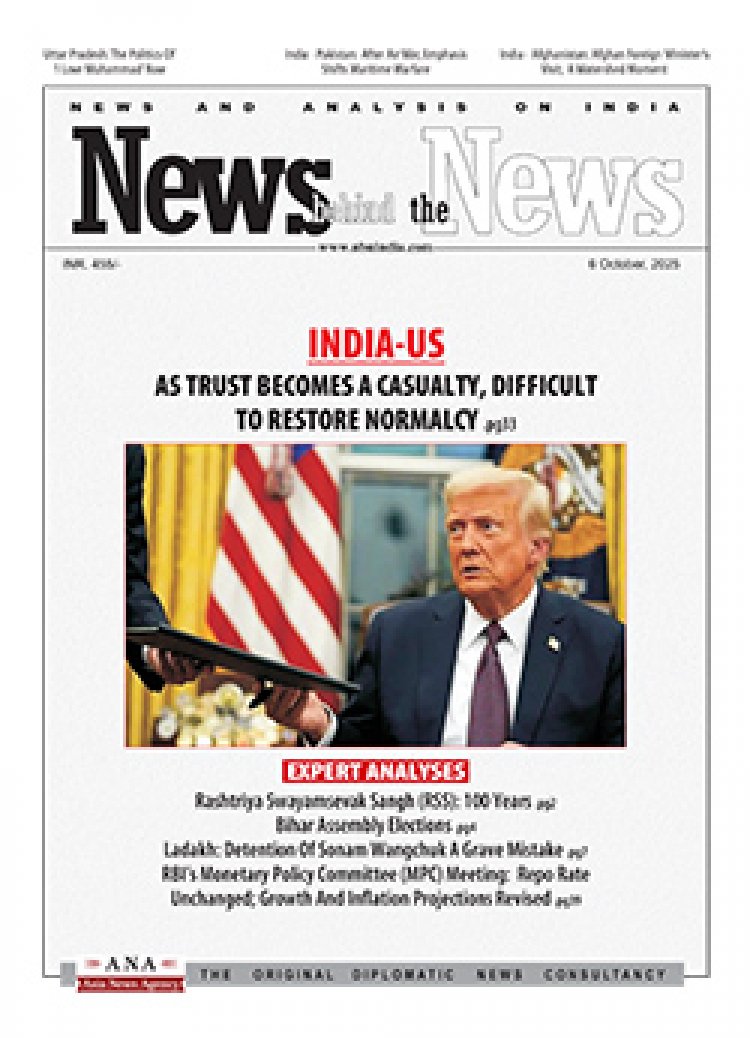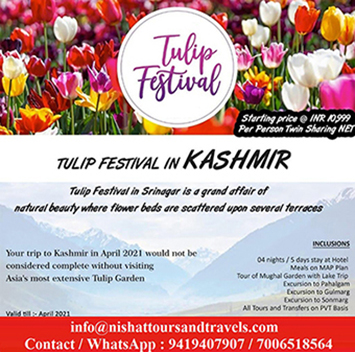Ladakh: Detention of Sonam Wangchuk A Grave Mistake
Asia News Agency

The detention of climate activist Sonam Wangchuk under the National Security Act and allegations hurled at him by the BJP and the government, writes The Hindu “mark a further deterioration of the situation in Ladakh, a sensitive border region. Mr. Wangchuk had been spearheading a movement on behalf of civil society groups demanding Statehood for Ladakh and its inclusion under the Sixth Schedule of the Constitution, which turned violent on September 24, 2025. To pin the blame on him for the violence, as the government and the police appear to be doing, is unwise and flies in the face of facts….”
J&K CM Omar Abdullah’s support for Wangchuk
Coming out in defence of Wangchuk, Chief Minister of Jammu and Kashmir Omar Abdullah said that until two days ago, the Centre saw no fault in climate activist Sonam Wangchuk, but then everything changed. ‘When he (Wangchuk) praised the Prime Minister as an environmental warrior, nobody found fault with him. And when he celebrated in 2019, profusely, for fulfilling the dreams of Ladakhis by granting them UT status, nobody objected either. Today, suddenly, we are told there is a Pakistani connection,’ said Abdullah. ‘Two days ago, there was no Pakistani connection. Now suddenly, there is one. And then you wonder why there is a trust deficit,’ Omar remarked.
A longtime supporter of the Centre
Wangchuk has been a supporter of the Centre’s decision, in 2019, to bifurcate the erstwhile State of Jammu and Kashmir into Union Territories (UT), in the hope that Ladakh would be granted full statehood and its indigenous culture and heritage protected by inclusion in the Sixth Schedule subsequently. The BJP did make a public commitment, at least on the question of the Sixth Schedule. Developments following the carving out of Ladakh as a UT followed an opposite pattern, leaving the native population feeling alienated. The Centre did start negotiations and arrived at a tentative agreement with the groups on May 27, 2025, which unravelled for reasons that remain unclear. But the mistrust among the protesters, and with the Centre is apparent. The Centre is now planning to continue with talks even as Mr. Wangchuk is in jail in Jodhpur.”
The use of the CBI and ED to overcome a political situation, the violence notwithstanding, “betrays a lack of statesmanship. The situation is such that any agreement with other interlocutors while Mr. Wangchuk remains detained will carry little legitimacy in the eyes of the world or Ladakh. It is also extremely counterproductive to accuse the people or the leaders of the movement in Ladakh of disloyalty to the nation, as many allies of the BJP are doing brazenly….”
Attempts to link Wangchuk to hostile neighbouring countries
The arrest and incarceration of climate activist Sonam Wangchuk and the attempts to link him to hostile neighbouring countries, writes The Asian Age “betray the Union government’s total disconnect with the ground realities and the resultant ad hoc and untenable positions it so often takes when faced with real-life political crises…..attempts to portray Mr Wangchuk’s attendance at an event hosted by The Dawn in Pakistan and his so-called visit to Bangladesh as covert links to those countries are laughable…..”
Nirupama Subramanian (independent journalist) clarifies his visit to Pakistan was as an “invitee to a conference organised by Dawn group, one of Pakistan’s leading media houses. The conference was about tackling climate change….” Subramanian was also invited. “The media group brought together people from Bangladesh, Bhutan, Nepal and India, making the case that climate change was a challenge that needed an ‘all of South Asia’ approach…”
Wangchuk’s detention under the NSA, writes Shikha Mukerjee (senior journalist) “is one more instance when State power is being deployed against a popular agitation that could spiral into a mass movement — the final outcome of which would be a change in the status of Ladakh in recognition of the legitimate demand of the people.”
The demands and the process of talks
Vijaita Singh (Deputy Editor, The Hindu) provides a backdrop to the agitation.
After the special status of Jammu and Kashmir under Article 370 was revoked on August 5, 2019 and the State was split into two Union Territories — J&K and Ladakh, the latter without an Assembly. The fear of big businesses and conglomerates taking away land and jobs from the local people concerned the people of Ladakh.
On September 10, Wangchuk, on behalf of the Leh Apex Body (LAB) and the Kargil Democratic Alliance (KDA), announced a 35-day hunger strike along with 15 others to demand the resumption of talks with the Union Ministry of Home Affairs (MHA). They had four demands: inclusion of Ladakh in the Sixth Schedule of the Constitution (tribal status), Statehood, separate Lok Sabha seats for Leh and Kargil, and filling of existing government vacancies.
In January 2023, following campaigns by groups in Kargil and Leh demanding constitutional safeguards, protection of land, preservation of culture and demand for employment opportunities, the government formed a High-Powered Committee (HPC) headed by Minister of State for Home Nityanand Rai. The committee comprised members of LAB and KDA and civil society representatives, who rejected the HPC, saying only pro-government members appeared to have been picked. The HPC was reconstituted on November 30, 2023.
The talks broke down in March 2024. On October 6, 2024, Mr. Wangchuk sat on an indefinite fast in Delhi to draw the government’s attention to their demands, following which the MHA agreed to resume talks.
The government’s case: Following this, on June 3, President Droupadi Murmu notified four Regulations for the Union Territory of Ladakh, defining new policies on reservation, languages, domiciles and composition of hill councils for Ladakh. The Regulations paved the way for 85% reservation for resident Ladakhis in government jobs. The Ladakh groups allege that their core demands of Statehood and inclusion in the Sixth Schedule have not been met.
After the violent protests, the MHA said in a statement that it had been actively engaged with LAB and KDA and a series of meetings were held. ‘The process of dialogue through this mechanism has yielded phenomenal results by increasing reservations for Ladakh’s Scheduled Tribe[s] from 45% to 84%, providing one-third reservations to women in the councils and declaring Bhoti and Purgi as official languages. With this process of recruitment, 1,800 posts opened up for tribals,' the MHA said.
Ladakh: a data profile
Identity has been a central part of Ladakh’s journey, from being part of Jammu & Kashmir, to attaining Union Territory status in 2019, and now to their demands.
Leh and Kargil: Ladakh shows a stark duality in its religious and linguistic makeup. As of 2025, it comprises seven districts, though before the Jammu & Kashmir Reorganisation Act it consisted of just two — Leh and Kargil.
Throughout the Union Territory’s history, the two districts have often tussled over recognition, particularly on questions of identity. Census 2011 data show that while over 65% of Leh’s population is Buddhist, more than 75% of Kargil’s population is Muslim.
The tribal face: Data also show that 71% of people in the Leh district and more than 86% of Kargil’s population belong to Scheduled Tribes, according to the 2011 census. In Leh, the Boto tribe, accounting for about 77.5% of the tribal population, primarily follows Buddhism. In Kargil, the Purigpa tribe make up nearly 32% of the tribal population, while the Baltis make up 30%. Majority of members from both tribes practice Islam.
The language divide: A population divide is also reflected in language. In Leh, nearly 70% of the population speaks Bhotia, compared with just over 10% in Kargil. In contrast, Kargil has a majority of Tibetan speakers, accounting for 66% of its population, according to the 2011 census.
Geography: Much of Ladakh’s terrain lies at high altitudes, nestled in the Himalayas, with most of its population living in its deep valleys. It is classified as a cold desert landscape, which is an arid area that receives low amounts of precipitation, majorly in the form of snow.
Degraded land area: Tree cover accounts for only 2% of Ladakh’s geographical area — the lowest among all States and Union Territories in India. For comparison, tree cover makes up about 25% of India’s terrain. A little less than half of its land area is ‘degraded', or has experienced a decline in biological productivity via factors such as soil erosion, deforestation, overgrazing, and more.
Health and education: Only 5% of women in Ladakh are covered by health insurance, while 18% of men in the UT are insured. This pales in comparison to the all-India average, wherein around 30% of men and women are covered by health insurance.
When it comes to education, and specifically primary education, Ladakh is significantly behind the national average, with nearly one-third of eligible children not enrolled in elementary school. In comparison, only 4% of children across India have not been enrolled in elementary school.
Employment: More than 30% of women in Ladakh have had no schooling. Of those that are employed, seven out of ten women in Ladakh are engaged in agriculture and allied activities. In comparison, only two in ten Ladakhi men are engaged in these activities. Sizable shares of men in Ladakh are employed in the public administration and defense sector (12.4%) while others work in agriculture, construction, and the trade and repair of motorcycles.
(Source: National Family Health Survey, 2011 Census, NITI Ayog SDG indicators)
















